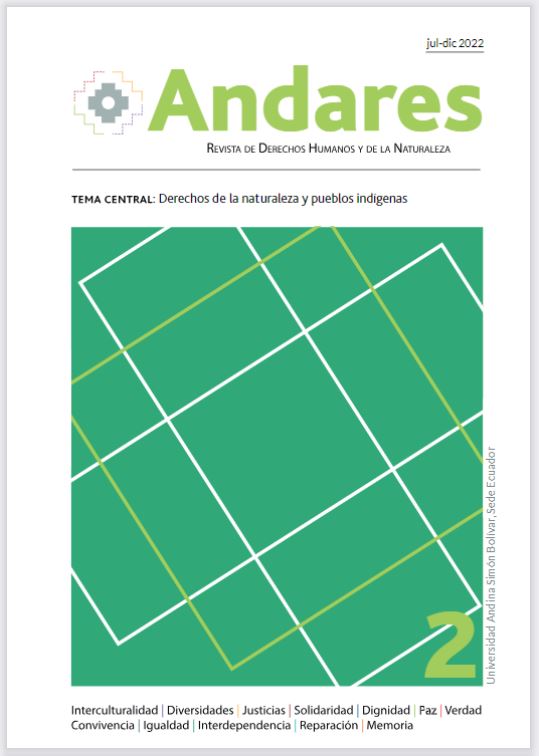The Hermeneutics of the Term Biodiversity According to the Constitution of Ecuador
DOI:
https://doi.org/10.32719/29536782.2022.2.5Keywords:
biodiversity, legal pluralism, nature, natural resources, public interestAbstract
The Constitution of Ecuador opted for an inclusive and integrating vision that brought together the European idea and the Amerindian notion of Nature and the Environment. From there, various contradictions are reproduced in the constitutional text in developing principles, rights, and precepts. This article analyzes the interpretation of the term biodiversity in the current Constitution of Ecuador, the existing contradictions between the definitions and terms included in the constitutional text, and the significance of biodiversity in an intercultural country where nature is recognized as a subject of rights. Likewise, this article studies how Ecuador has transited between two different perspectives of perceiving the Environment and Nature in less than three decades. Also, it examines if the intercultural interpretation of biodiversity is correctly positioned in the constitutional text. In addition, the article analyzes the Ecuadorian environmental regulations, focusing on the development of the constitutional precepts related to biodiversity, and highlights the need for the inclusion of concepts such as Pacha Mama and Interculturality. Finally, when analyzing the development of biodiversity valuation, the article concludes that environmental regulations are regressive and reaffirm a utilitarian vision about the resources, even in the context of traditional knowledge guaranteed in the Constitution of Ecuador.
Downloads
References
Arráez, Morella, Josefina Calles y Liuval Moreno de Tovar. “La hermenéutica: Una actividad interpretativa”. Sapiens. Revista Universitaria de Investigación 7, n.° 2 (2006): 171-81. https://bit.ly/2XSFYuy.
Arteta, Cristóbal. Hermenéutica, pedagogía y praxeología. Barranquilla, CO: Universidad Libre Seccional Barranquilla, 2017.
Barney, Gerald, ed. The Global 2000 Report to the President, vol. 2: The Technical Report. Washington DC: US Government Printing Office, 1980.
Council on Environmental Quality. Environmental Quality: The Eleventh Annual Report of the Council on Environmental Quality. Washington DC: Council on Environmental Quality, 1980.
Cruz, Edwin. “Del derecho ambiental a los derechos de la naturaleza: Sobre la necesidad del diálogo intercultural”. Jurídicas 11, n.° 1 (2014): 95-116. https://bit.ly/3U8Jlt3.
De la Cruz, Rodrigo. “Conocimiento tradicional y plantas útiles en el Ecuador: Valoración, protección y legislación”. En Conocimiento tradicional y plantas útiles del Ecuador: Saberes y prácticas, de Montserrat Ríos, Rodrigo de la Cruz y Arturo Mora, 31-48. Quito: IEPI / Fundación Pachamama / Universidad Politécnica Salesiana / Abya-Yala, 2008.
Ecuador. Código Orgánico de la Economía Social de los Conocimientos, Creatividad e Innovación. Registro Oficial 899, Suplemento, 9 de diciembre de 2016.
—. Código Orgánico del Ambiente. Registro Oficial Suplemento 983, 12 de abril de 2017.
—. Constitución de la República del Ecuador. Registro Oficial 800, 27 de marzo de 1979.
—. Constitución de la República del Ecuador. Registro Oficial 449, 20 de octubre de 2008.
—. Constitución Política de la República del Ecuador. Registro Oficial 1, 11 de agosto de 1998.
Ecuador Corte Constitucional. “Sentencia: Revisión de garantías”. Caso n.° 1149-19-JP/20, 10 de noviembre de 2021. https://bit.ly/3VBrNab.
Ferreti, Degmar. “La protección jurídica de los conocimientos tradicionales: Aportaciones al desarrollo de un sistema sui generis”. Tesis doctoral, Universidad de Salamanca, España, 2011. https://bit.ly/3VPOlV1.
Klier, Gabriela. “La biología de la conservación: Entre hegemonías y fugas”. Ecología Política 58 (2019): 75-8. https://bit.ly/3U82taN.
Noss, Reed. “Indicators for Monitoring Biodiversity: A Hierarchical Approach”. Conservation Biology 4, n.° 4 (1990): 355-64. https://bit.ly/3Xw70Xp.
Núñez, Irama, Édgar González y Ana Barahona. “La biodiversidad: Historia y contexto de un concepto”. Interciencia 28, n.° 7 (2003): 387-93. https://bit.ly/3ic3Wj8.
ONU. Convenio sobre la Diversidad Biológica. 1992. https://bit.ly/3u9wxs1.
—. Informe de la Conferencia de las Naciones Unidas sobre el Medio Humano. Nueva York: ONU, 1973.
Posey, Darrell, y Graham Dutfield. Más allá de la propiedad intelectual. Montevideo: Centro Internacional de Investigaciones para el Desarrollo / Nordan-Comunidad / Fondo Mundial para la Naturaleza, 1996.
Reyes, Yenán. “Protección jurídica de saberes ancestrales vinculados a la biodiversidad del Ecuador en el marco normativo vigente”. Tesis de licenciatura, Pontificia Universidad Católica del Ecuador, 2017. https://bit.ly/3AQnxMi.
Ruiz, Mónica. “Saberes ancestrales y el componente intangible asociado”. Revista Ruptura 56 (2012): 489-512. https://bit.ly/3GRutMI.
Toledo, Víctor. “La diversidad biológica de México: Nuevos retos para la investigación de los noventa”. Ciencias 34 (1994): 43-57. https://bit.ly/3EJYQSS.







